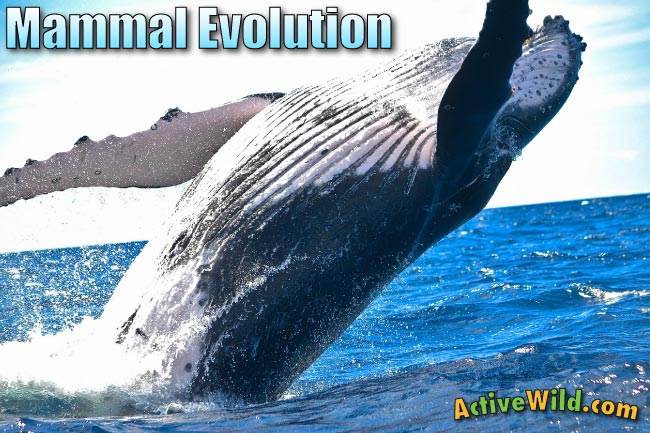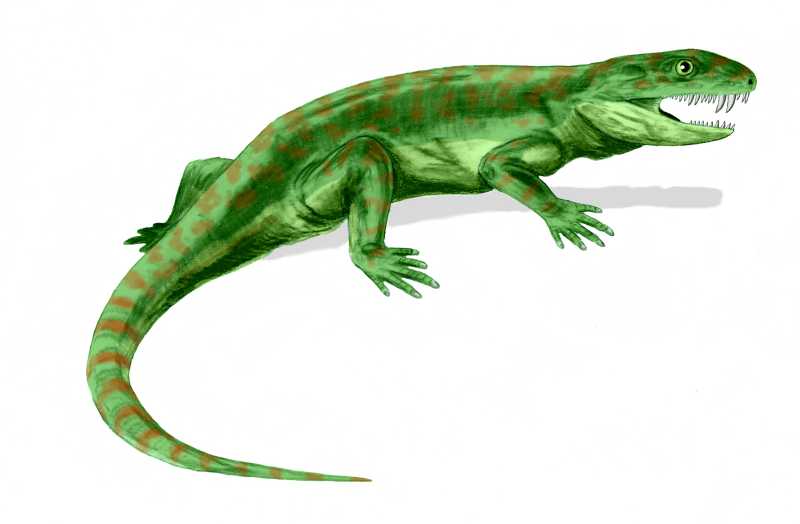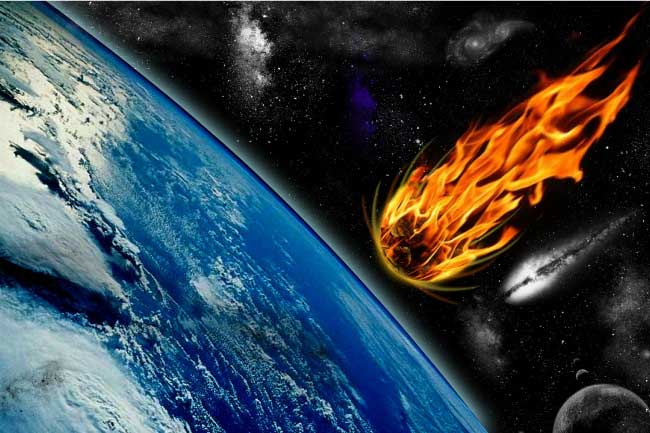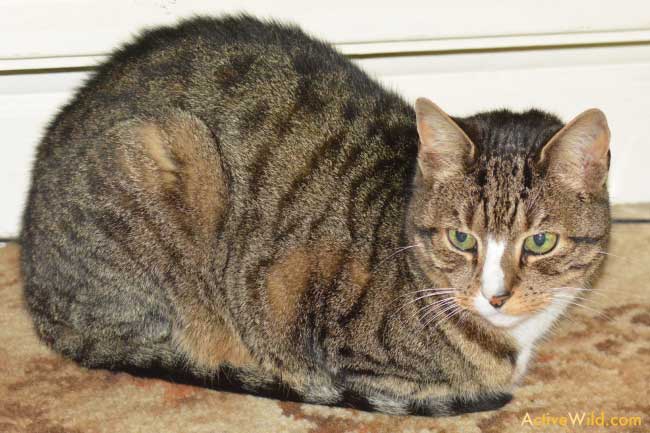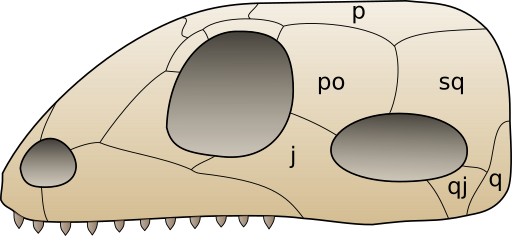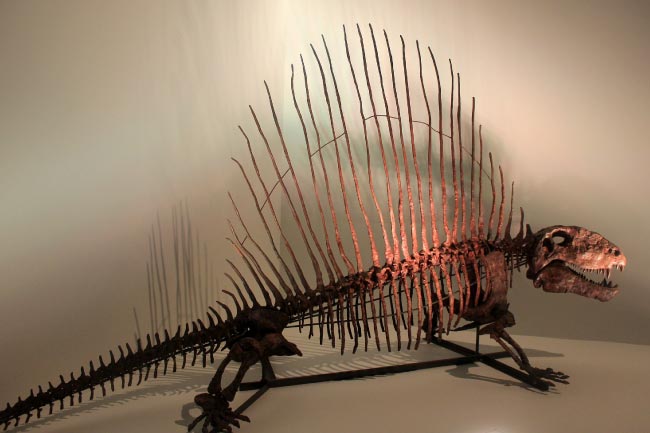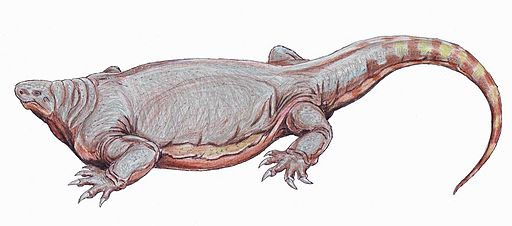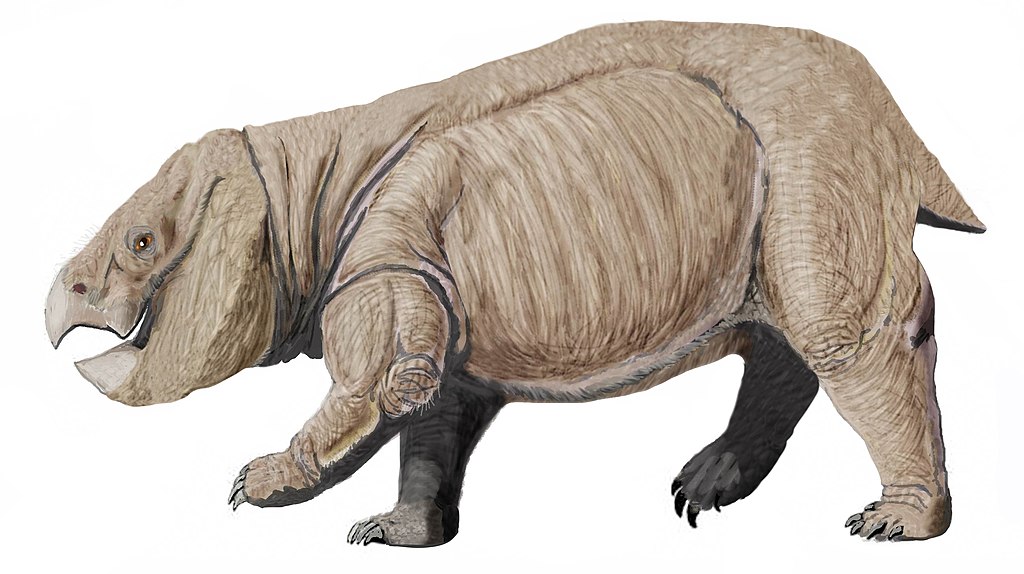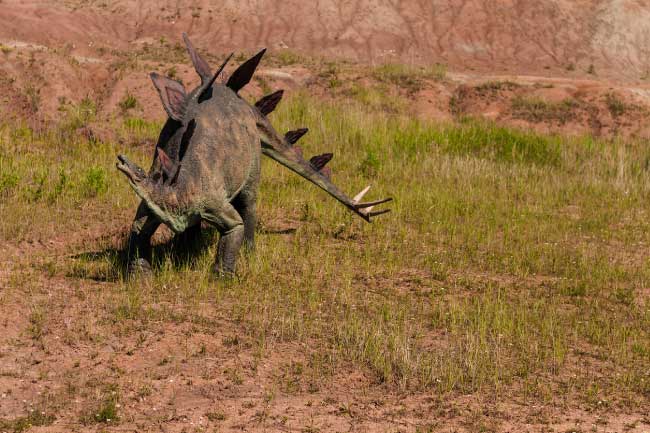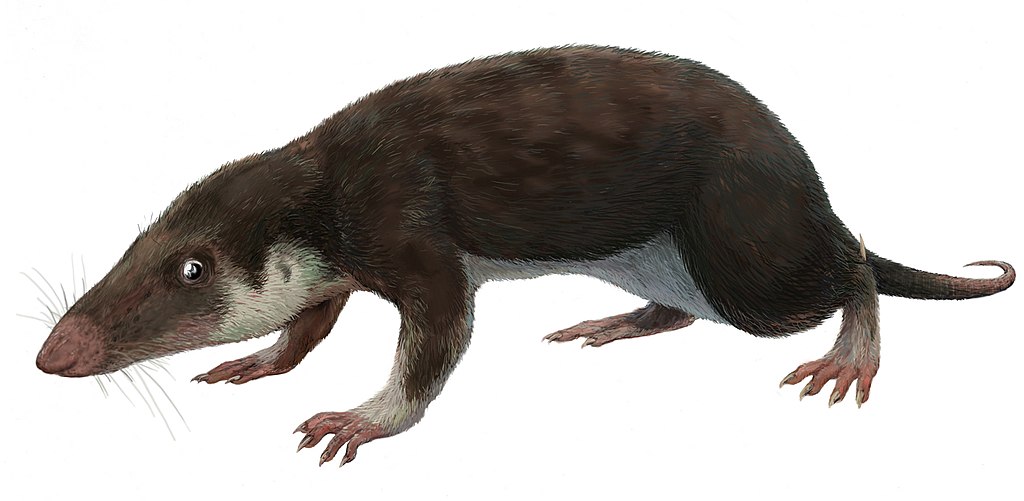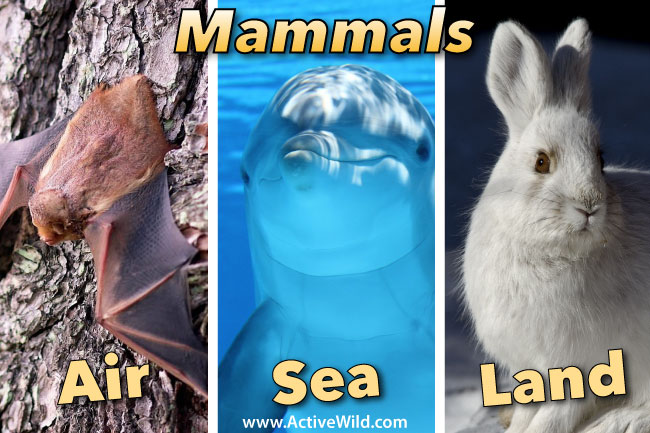Mammal Evolution: Part Four of our Ultimate Guide to Mammals.
Other pages in this series:
- Part One: Mammals: An Introduction
- Part Two: What Is A Mammal?
- Part Three: Types of Mammal
- Is a bird a mammal?
- Are sharks mammals?
- Is a dolphin a mammal?
On this page, we’re going to go back in time in order to meet the very first mammals and their ancestors.
The Evolution of Mammals: Introduction
The first mammals appeared around 225 million years ago, in the late Triassic Period. However, the story of mammals began millions of years before then.
On this page, we’re going to discover how amphibians lost their dependence on water and evolved into two main groups of land animals, one of which would include the ancestors of all of today’s mammals.
On the way, we’re going to meet some weird and wonderful animals, many of which are your ancestors!
Oh, and if you think that your early ancestors were all cuddly and chimp-like, we’ve got news for you: they actually looked more like dinosaurs!
Mammal Evolution: The Story
The evolution of mammals is a story that takes place over hundreds of millions of years.
In the course of the story Earth is devastated by not one but three major extinction events. Each one was responsible for wiping out huge numbers of species.
We don’t know where the story will end: perhaps man will venture into space, or perhaps we’ll end up destroying the very planet whose resources enabled us to thrive.
The future is in our hands!
… Unless a huge asteroid emerges from the depths of space on a collision course with Earth. It’s probably best not to think about that!
Mind … blown!
This may blow your mind: lions, mice, gorillas, and every other mammal alive today – including you – came from just one species of animal!
That’s right; in just the same way that your cousins have the same grandparents as you, if you go far enough back in time, then you’ll find a single species that gave rise to whales, wolves, cats, bats, your grandparents, your cousins, and you!
In scientific terms, this species is the called the ‘most recent common ancestor’ of mammals. This is often shortened to ‘MRCA’.
So if you considered your pet cat to be a member of your family, you were – sort of – right!
We'll meet our most recent common ancestors further down the page.
Leaving The Water
Amniotes
The story of mammals begins in prehistoric lakes and rivers, when amphibians first ventured onto land.
The early ancestors of both mammals and reptiles were called amniotes. These reptile-like animals evolved from amphibians. Unlike amphibians, amniotes could fertilize and lay their eggs away from the water.
Amniotes appeared around 312 million years ago in the late Carboniferous Period of the Paleozoic Era.
The early amniotes were small, lizard-like animals. Freed from the constraints of having to return to the water to breed, they could inhabit a wide range of habitats.
The amniotes soon split into two main branches: the synapsids, and the sauropsids.
Synapsids Vs Sauropsids: Mammals Vs Reptiles
As you may have guessed, you’ve just met your ancestors! The synapsids are the ancestors of all mammals. (Strictly speaking, mammals ARE synapsids.) However, it would be a long time before the true mammals would appear.
The other main branch of amniotes was the sauropsids. These were early reptiles, and a branch called the diapsids were the ancestors of modern reptiles, dinosaurs and birds, as well as prehistoric reptiles such as plesiosaurs and ichthyosaurs.
(As you’ll know if you’ve read our dinosaur pages, birds are the descendants of theropod dinosaurs, and many scientists consider them to be the last remaining dinosaurs.)
Diapsids had two openings on either side of their skulls, just like today’s birds and reptiles. (Many scientists believe that although today’s Testudines (Turtles, tortoises and terrapins) don’t have any extra openings in their skulls, their ancestors did.)
Pelycosaurs
Early synapsids called pelycosaurs became the dominant large land animals during the early Permian Period. An example of a pelycosaur is the dimetrodon, an apex predator that grew to over 4 m (13 ft.) in length.
Although dimetrodon still looked very reptilian, it was more closely related to mammals.
Another pelycosaur was the Cotylorhynchus, a 3 m (10 ft.) long animal with a huge round body and tiny head. Its legs were sprawled like a reptile, but it had a mammal-like single opening on either side of its skull.
Therapsids
The pelycosaurs were replaced later in the Permian Period by another group of synapsids called therapsids.
The therapsids thrived, with different branches becoming predators, plant-eaters and burrowers.
Therapsids became increasingly mammal-like, developing legs that extended downwards from their bodies rather than sprawling out sideways like those of reptiles.
Mammal Evolution Clues In Poo!
It's possible that Dicynodonts were endothermic (warm-blooded), and that they had hair. Both of these are mammalian characteristics, as you’ll know if you’ve read the first part of this series: What Is A Mammal?
Scientists know Dicynodonts had hair by studying coprolites (you guessed it, fossilized poo) from Permian predators that preyed on Dicynodonts.
Permian–Triassic Extinction Event
252 million years ago, Earth was rocked by the Permian–Triassic Extinction Event. It was, and still is, the world’s most devastating extinction event. It is known as ‘The Great Dying’.
The Permian–Triassic Extinction Event marked the end of the Paleozoic Era and the start of the Mesozoic Era.
Amazingly, it was even more destructive than the later Cretaceous–Paleogene extinction event, which was responsible for wiping out the dinosaurs. (We’ll get to them later!)
Up to 75% of all species, including many of the early mammal-like animals, became extinct during the Permian–Triassic Extinction Event. Possible causes for the extinction event include an asteroid strike and mass volcanic eruptions.
Some Dicynodonts survived, including the Lystrosaurus, a pig-sized herbivore that had a beak and two tusk-like teeth. Lystrosaurus was the most common land animal of the Early Triassic.
Placerias also made it through the mass extinction.
Cynodonts
Other therapsids called cynodonts had appeared in the Permian period and were now diversifying. The cynodonts were the ancestors of all modern mammals.
Thrinaxodon was a dog-sized, carnivorous cynodont that lived in what is now South Africa. It had a mammalian lower jaw and teeth that had specific functions (e.g. some were for cutting, others were for biting or chewing – just like those of a mammal).
There is also evidence that thrinaxodon had hair and whiskers. All of these are characteristics of mammals.
Traversodontidae was a family of herbivorous cynodonts that appeared in the Triassic Period. They were widespread, having been found in Europe, Africa and the Americas, but disappeared in the Early Jurassic.
Rise Of The Dinosaurs … And The True Mammals
The Mesozoic Era is known as the ‘Age of Reptiles’. As you may have guessed, things didn’t go too well for the early mammals during this time!
During the course of the early Triassic Period of the Mesozoic Era, sauropsids called Archosaurs established dominance on the land.
There were two main branches of archosaur: Pseudosuchia, (early crocodile-like animals and the ancestors of modern crocodiles) and Ornithosuchia.
Ornithosuchia included the dinosaurs and pterosaurs. With these guys around, the bigger early mammals didn’t stand much of a chance, and the larger cynodonts became extinct.
The First Mammals
However, as dinosaurs became dominant, the therapsids continued to evolve.
The surviving therapsids were small, but increasingly mammal like. Around 225 million years ago, the first true mammals began to appear.
The first mammals were small, nocturnal insectivores (insect eaters), similar in appearance to today’s rodents.
Monotremes, Marsupials & Placental Mammal Evolution
The early mammals were egg-laying animals. The marsupials and placental mammals (both of which give birth to live young) would branch off later, leaving today’s five monotreme species as the only modern egg-laying mammals.
- You can find out more about the different types of mammal here.
Sinoconodon rigneyi can either be thought of as one of the first known mammals, or a member of an intermediate group of animals called Mammaliformes. It lived in China around 193 million years ago.
It was small and although rodent-like, was still a very early mammal: it had teeth were continually replaced (unlike those of a modern mammal), and it almost certainly laid eggs.
Shrew-like in appearance, Morganucodon watsoni fed its young with milk, and probably had hair.
Triassic-Jurassic Extinction Event
The first mammals survived the Triassic-Jurassic extinction event that occurred 201.3 million years ago.
This mass extinction wiped out around half of the Earth’s species. Most of the archosaurs that weren’t dinosaurs became extinct, as did many therapsids.
The dinosaurs, early crocodiles and pterosaurs survived. It was dinosaurs that would rule the Jurassic and Cretaceous periods.
Mammal Evolution And The Nocturnal Bottleneck
The success of the dinosaurs meant that most mammals became nocturnal and insectivorous (insect-eating). This is put forward as the underlying reason behind many mammalian characteristics – a theory known as the ‘Nocturnal Bottleneck’.
Hunting at night requires excellent senses of smell, hearing and touch. Having external ears and whiskers would have been extremely beneficial to small animals living alongside dinosaurs.
An insect-based diet would have required teeth that could grab and crush nimble prey.
Being warm-blooded would have enabled mammals to hunt at night when it would have been too cold for cold-blooded reptiles.
Predatory Early Mammals
Fossil evidence suggests that some Jurassic mammals, such as Castorocauda and Haldanodon were semi-aquatic fish-eaters.
Repenomamus, which lived in China during the Cretaceous period, was one of the largest mammals of its time. Reaching 14 kg (31 lb.) – around the size of an average dog – this predatory mammal preyed on small dinosaurs.
We know this because a repenomamus fossil was found with the remains of a dinosaur in its stomach! (Although, of course, repenomamus could have been a scavenger, rather than an active predator.)
Other Cretaceous mammals could glide, some had quills, and some were active during the day.
The End Of The Dinosaurs
Although the dinosaurs had been an extraordinarily successful group of animals, dominant for many millions of years, their reign eventually came to an end.
The end of the dinosaurs –and of the Mesozoic Era – came with the Cretaceous–Paleogene Extinction Event, which occurred around 66 million years ago. This event – thought to have been caused by an asteroid impact – caused the extinction of 75% of all species on Earth.
You can find out more about the end of the dinosaurs here.
It wasn’t only the (non-avian) dinosaurs* that were affected. Pterosaurs and plesiosaurs and mollusks such as ammonites became extinct. Many mammals, birds, fish and plants were also wiped out.
* Birds – which many scientists today consider to be dinosaurs – were the only dinosaurs to survive.
The Cenozoic Era: Age Of Mammals
The Cretaceous-Paleogene Extinction Event marked the end of the Mesozoic Era and the beginning of the Cenozoic Era.
The Paleogene Period And The Rise Of The Mammals
The first period of the Cenozoic Era was the Paleogene Period. Now, with the dinosaurs out of the way, the scene was set for the rise of the mammals.
The surviving mammals were small, shrew-like animals. However, now there was little or no reptilian competition, they soon diversified.
Mammals experienced an adaptive radiation that would see them filling many new niches, not just on land, but also in the water and in the air.
(An adaptive radiation is when many species spring from a single ancestor following a favorable change in their environment.)
Birds too underwent an adaptive radiation at this time.
In a relatively short period of time, mammals came to dominate virtually every environment on land. During the Paleogene and Neogene Periods, all of the current mammalian orders were established.
The rest, as they say, is history. Whereas the Mesozoic Era is known as the ‘Age of Reptiles’, the Cenozoic Era is known as the ‘Age of Mammals’. (It’s also known as the ‘Age of Birds’ due to their dominance of the skies.)
Mammal Evolution: Conclusion
In this article we’ve traced the evolution of mammals from the amniotes to the adaptive radiation that saw mammals become the dominant land animals at the beginning of the Cenozoic Era.
The amniotes were descended from amphibians. Having lost their dependence on water, they split into two main branches. One branch would become the modern reptiles and the birds, the other the mammals.
The ancestors of the mammals were at one time the dominant animals on land. However, after two devastating extinction events, the early mammals’ hold on the land was weakened.
During the Triassic Period the reptiles became dominant. The dinosaurs became one of the most successful groups of animals the world has ever known.
However, it was during the Triassic Period that the common ancestor of all mammals appeared. It is likely that mammalian characteristics were shaped during the time the early mammals shared Earth with the dinosaurs.
The Cretaceous–Paleogene Extinction Event spelled the end of the dinosaurs and the beginning of the Cenozoic Era; the ‘Age of Mammals’.
We hope that you’ve enjoyed this journey into your dim and distant past. If you liked this article, then be sure to tell your friends about it by sharing it on social media using the buttons at the top of the page. Teachers and parents are also welcome to link to this page from their own websites.
Now you know all about mammal evolution, check out the other pages in this series:
- Go to Part One: Mammals: An Introduction
- Go to Part Two: What Is A Mammal?
- Go to Part Three: Types of Mammals
- Is a bird a mammal?
- Are sharks mammals?
- Is a dolphin a mammal?

